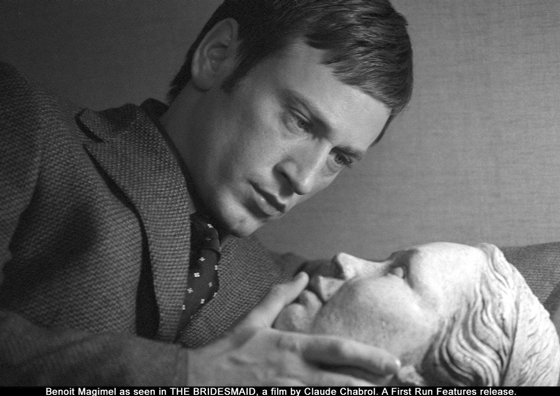By Leonard Quart
Courtesy First Run Features
In Claude Chabrol’s film “The Bridesmaid,” Benoît Magimel falls hard for a stony woman. It’s now playing at the Angelika.
Claude Chabrol, Francois Trauffaut and Jean-Luc Godard were the leading members of the French New Wave in the 1960s. All New Wave directors were committed to a cinema that expressed a personal vision, and in very different ways they defied mainstream cinematic conventions.
Of the three, however, Chabrol was the most commercial and flexible, making mediocre espionage films, and ironic and striking Hitchcockian psychological thrillers like “Le Boucher” and “La Femme Infidele” that evoke how conventional middle class life carries the seeds of uncontrolled passion, madness, and violence. In a Chabrol film, the underside of bourgeois order is always a barely suppressed chaos.
Now in his mid-70s, Chabrol is still a prolific filmmaker, though his recent work lacks the tautness and psychological subtlety of his earlier and best work. Those flaws are inherent in “The Bridesmaid,” which is based on a novel by Ruth Rendell, and set in a small suburban town not far from Paris. The film centers on the hard working, extremely responsible, emotionally constricted older son, who is part of a lower-middle class family that emanates more than a touch of unease. The son, Philippe (Benoît Magimel) — acts as a protective surrogate husband for his sweet, passive, widowed mother Christine (Aurore Clément), and a less watchful substitute father for his chain-smoking, rebellious, kleptomaniac younger sister Patricia (Anna Mihalcea). And he is also strangely obsessed with a Hellenic stone bust of a woman’s head (he sleeps with it) that was a gift from his late father.
The film suddenly shifts from a slow paced family drama into a charged erotic thriller when Phillip exchanges meaningful glances with Senta (Laura Smet). She’s a bridesmaid at his sister’s wedding, who resembles the classical bust. Senta is sexually aggressive, impulsive, and mysterious, and, in a peremptory manner, declares that she and Philippe are destined for each other (“you’re my other half”). She lives in the basement of a large decaying house, sleeps her days away, and tells a great many tall stories about her past and present.
Senta is profoundly unstable and emotionally needy—a very unsettling siren, who sees herself above law and morality. But Phillip is drawn to Senta, and though her pathological behavior wearies him, he cannot ultimately reject her. In fact, he becomes thoroughly entwined in her madness.
Chabrol, I assume, wants us to believe that Phillip is so overwhelmed by his passionate sexual bond with Senta, that he has lost all reason. Or is he suggesting that the seeds of his behavior can be seen in Phillip’s relationship to the stone bust? Though the two leads work hard at giving dimension to their characters and situation, the film has no emotional reality or urgency. Senta is too outsized and operatic to be believable. And “The Bridesmaid” turns out to be a contrivance—rooted more in the manipulations of its narrative, than in the behavior or inner life of its characters.
































